2006 CHEVROLET UPLANDER belt
[x] Cancel search: beltPage 1 of 458

Seats and Restraint Systems........................... 1-1
Front Seats
............................................... 1-2
Rear Seats
............................................... 1-6
Safety Belts
.............................................1-21
Child Restraints
.......................................1-40
Airbag System
.........................................1-74
Restraint System Check
............................1-89
Features and Controls..................................... 2-1
Keys
........................................................ 2-3
Doors and Locks
......................................2-10
Windows
.................................................2-24
Theft-Deterrent Systems
............................2-26
Starting and Operating Your Vehicle
...........2-30
Mirrors
....................................................2-41
OnStar
®System
......................................2-42
Universal Home Remote System
................2-44
Storage Areas
.........................................2-48
Instrument Panel............................................. 3-1
Instrument Panel Overview
.......................... 3-4
Climate Controls
......................................3-24
Warning Lights, Gages, and Indicators
........3-31
Driver Information Center (DIC)
..................3-46
Audio System(s)
.......................................3-77Driving Your Vehicle....................................... 4-1
Your Driving, the Road, and Your Vehicle
..... 4-2
Towing
...................................................4-35
Service and Appearance Care.......................... 5-1
Service
..................................................... 5-3
Fuel
......................................................... 5-5
Checking Things Under the Hood
...............5-10
All-Wheel Drive
........................................5-43
Bulb Replacement
....................................5-45
Windshield Wiper Blade Replacement
.........5-49
Tires
......................................................5-50
Appearance Care
.....................................5-84
Vehicle Identi�cation
.................................5-92
Electrical System
......................................5-93
Capacities and Speci�cations
.....................5-99
Maintenance Schedule..................................... 6-1
Maintenance Schedule
................................ 6-2
Customer Assistance and Information.............. 7-1
Customer Assistance and Information
........... 7-2
Reporting Safety Defects
...........................7-14
Index................................................................ 1
2006 Chevrolet Uplander Owner ManualM
ProCarManuals.com
Page 7 of 458
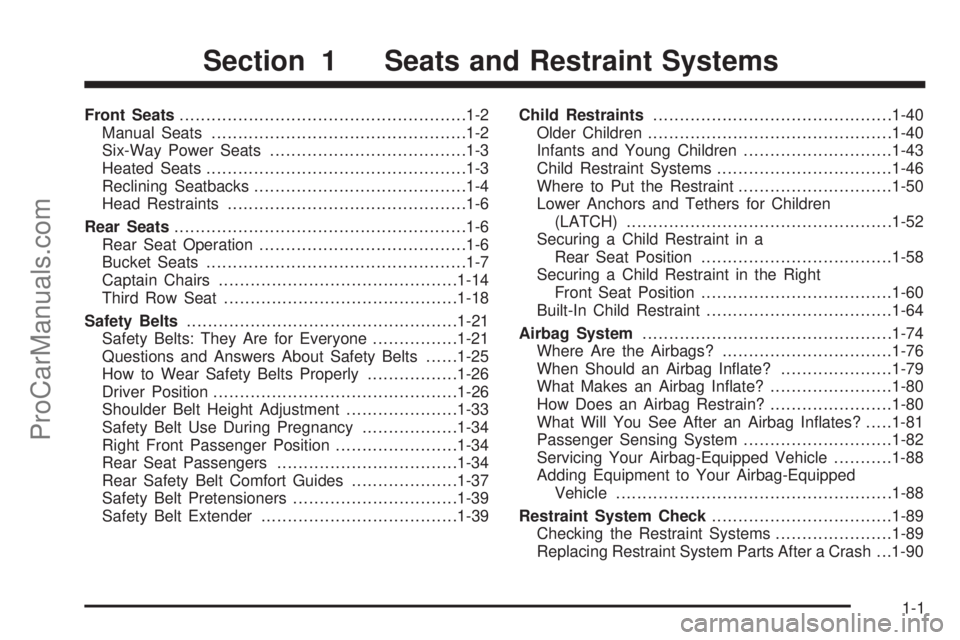
Front Seats......................................................1-2
Manual Seats................................................1-2
Six-Way Power Seats.....................................1-3
Heated Seats.................................................1-3
Reclining Seatbacks........................................1-4
Head Restraints.............................................1-6
Rear Seats.......................................................1-6
Rear Seat Operation.......................................1-6
Bucket Seats.................................................1-7
Captain Chairs.............................................1-14
Third Row Seat............................................1-18
Safety Belts...................................................1-21
Safety Belts: They Are for Everyone................1-21
Questions and Answers About Safety Belts......1-25
How to Wear Safety Belts Properly.................1-26
Driver Position..............................................1-26
Shoulder Belt Height Adjustment.....................1-33
Safety Belt Use During Pregnancy..................1-34
Right Front Passenger Position.......................1-34
Rear Seat Passengers..................................1-34
Rear Safety Belt Comfort Guides....................1-37
Safety Belt Pretensioners...............................1-39
Safety Belt Extender.....................................1-39Child Restraints.............................................1-40
Older Children..............................................1-40
Infants and Young Children............................1-43
Child Restraint Systems.................................1-46
Where to Put the Restraint.............................1-50
Lower Anchors and Tethers for Children
(LATCH)..................................................1-52
Securing a Child Restraint in a
Rear Seat Position....................................1-58
Securing a Child Restraint in the Right
Front Seat Position....................................1-60
Built-In Child Restraint...................................1-64
Airbag System...............................................1-74
Where Are the Airbags?................................1-76
When Should an Airbag In�ate?.....................1-79
What Makes an Airbag In�ate?.......................1-80
How Does an Airbag Restrain?.......................1-80
What Will You See After an Airbag In�ates?.....1-81
Passenger Sensing System............................1-82
Servicing Your Airbag-Equipped Vehicle...........1-88
Adding Equipment to Your Airbag-Equipped
Vehicle....................................................1-88
Restraint System Check..................................1-89
Checking the Restraint Systems......................1-89
Replacing Restraint System Parts After a Crash . . .1-90
Section 1 Seats and Restraint Systems
1-1
ProCarManuals.com
Page 11 of 458
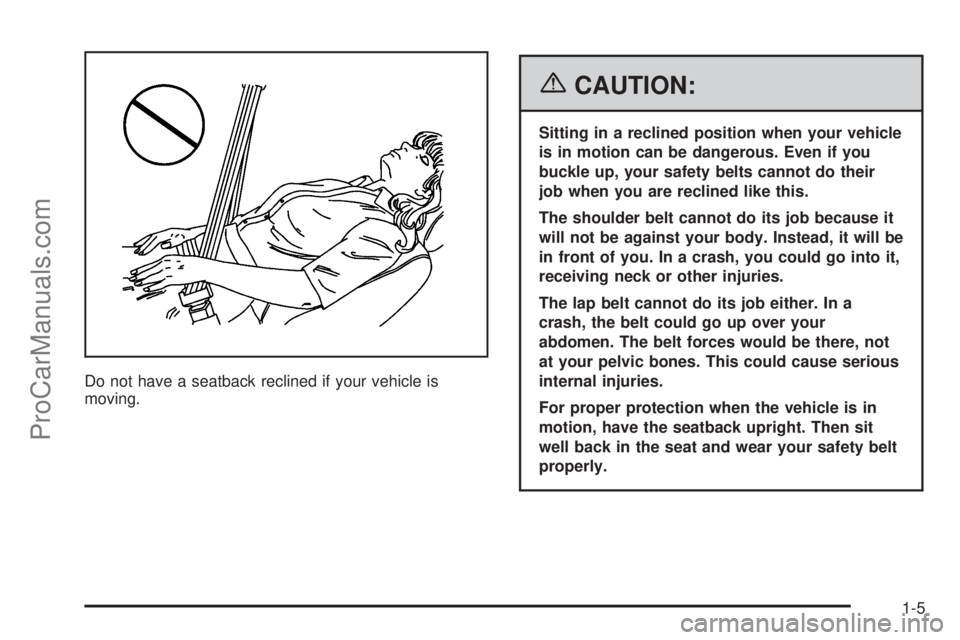
Do not have a seatback reclined if your vehicle is
moving.
{CAUTION:
Sitting in a reclined position when your vehicle
is in motion can be dangerous. Even if you
buckle up, your safety belts cannot do their
job when you are reclined like this.
The shoulder belt cannot do its job because it
will not be against your body. Instead, it will be
in front of you. In a crash, you could go into it,
receiving neck or other injuries.
The lap belt cannot do its job either. In a
crash, the belt could go up over your
abdomen. The belt forces would be there, not
at your pelvic bones. This could cause serious
internal injuries.
For proper protection when the vehicle is in
motion, have the seatback upright. Then sit
well back in the seat and wear your safety belt
properly.
1-5
ProCarManuals.com
Page 12 of 458
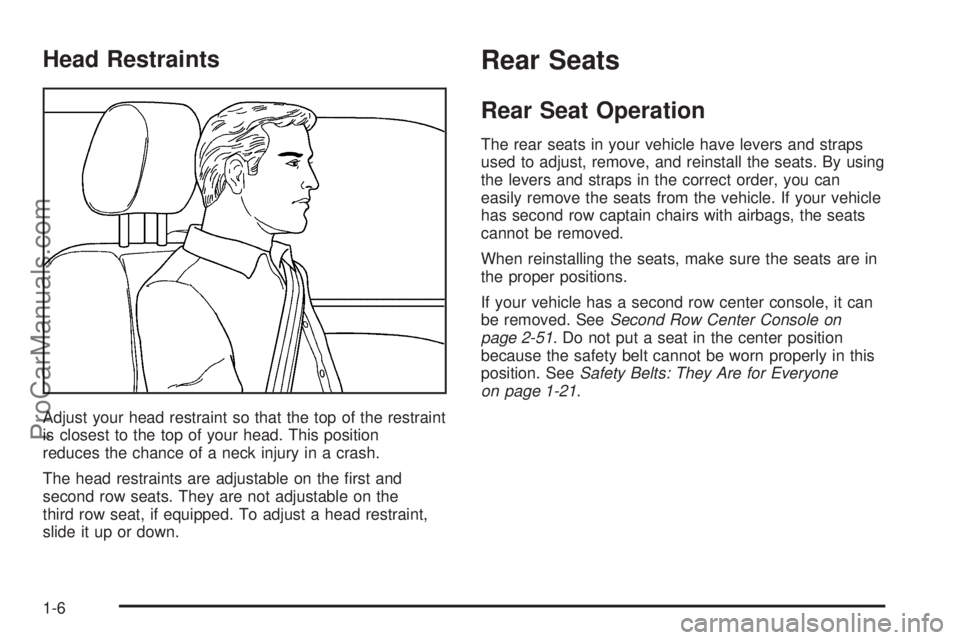
Head Restraints
Adjust your head restraint so that the top of the restraint
is closest to the top of your head. This position
reduces the chance of a neck injury in a crash.
The head restraints are adjustable on the �rst and
second row seats. They are not adjustable on the
third row seat, if equipped. To adjust a head restraint,
slide it up or down.
Rear Seats
Rear Seat Operation
The rear seats in your vehicle have levers and straps
used to adjust, remove, and reinstall the seats. By using
the levers and straps in the correct order, you can
easily remove the seats from the vehicle. If your vehicle
has second row captain chairs with airbags, the seats
cannot be removed.
When reinstalling the seats, make sure the seats are in
the proper positions.
If your vehicle has a second row center console, it can
be removed. SeeSecond Row Center Console on
page 2-51. Do not put a seat in the center position
because the safety belt cannot be worn properly in this
position. SeeSafety Belts: They Are for Everyone
on page 1-21.
1-6
ProCarManuals.com
Page 18 of 458
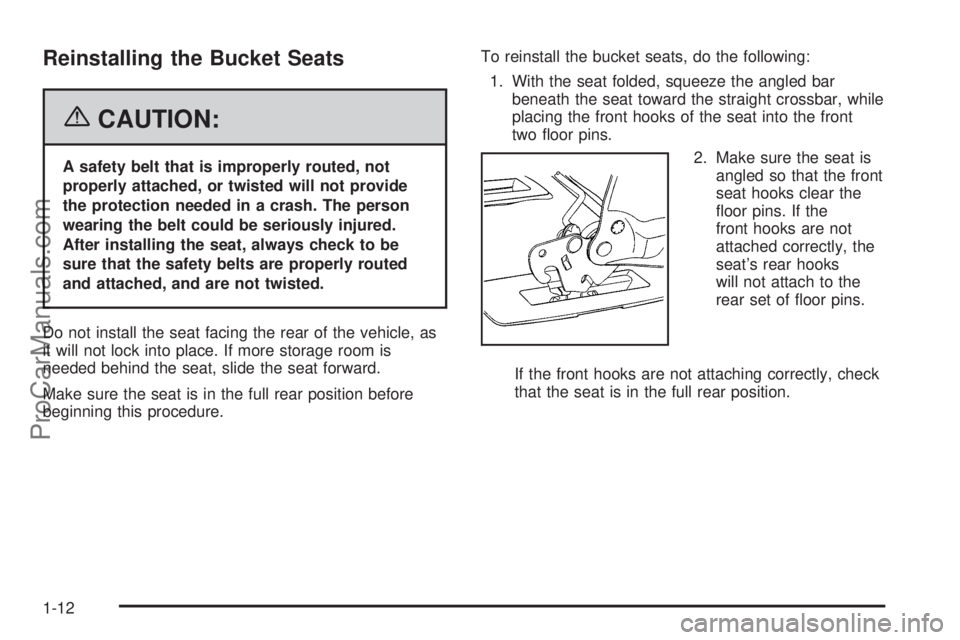
Reinstalling the Bucket Seats
{CAUTION:
A safety belt that is improperly routed, not
properly attached, or twisted will not provide
the protection needed in a crash. The person
wearing the belt could be seriously injured.
After installing the seat, always check to be
sure that the safety belts are properly routed
and attached, and are not twisted.
Do not install the seat facing the rear of the vehicle, as
it will not lock into place. If more storage room is
needed behind the seat, slide the seat forward.
Make sure the seat is in the full rear position before
beginning this procedure.To reinstall the bucket seats, do the following:
1. With the seat folded, squeeze the angled bar
beneath the seat toward the straight crossbar, while
placing the front hooks of the seat into the front
two �oor pins.
2. Make sure the seat is
angled so that the front
seat hooks clear the
�oor pins. If the
front hooks are not
attached correctly, the
seat’s rear hooks
will not attach to the
rear set of �oor pins.
If the front hooks are not attaching correctly, check
that the seat is in the full rear position.
1-12
ProCarManuals.com
Page 22 of 458
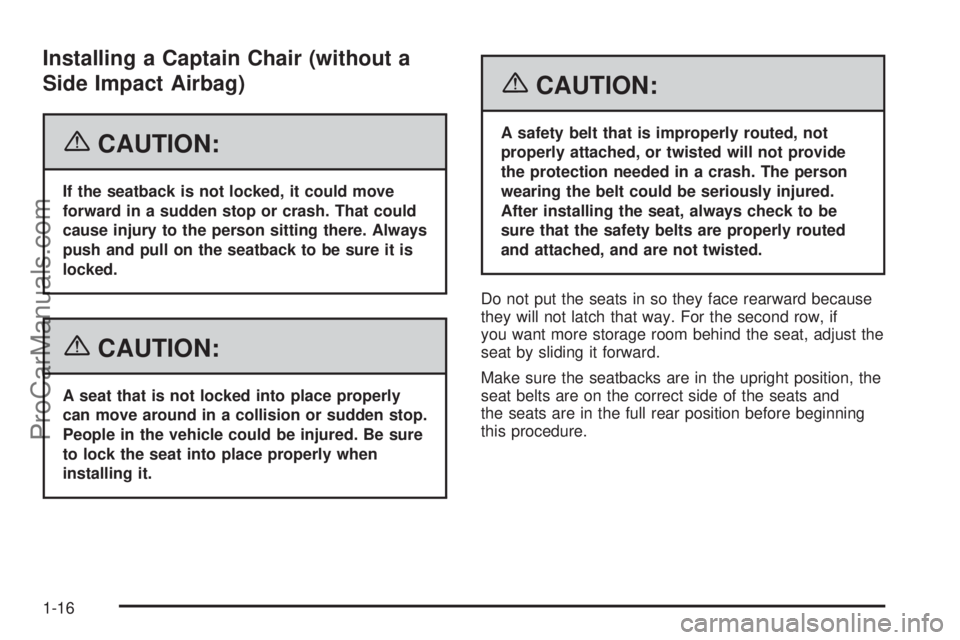
Installing a Captain Chair (without a
Side Impact Airbag)
{CAUTION:
If the seatback is not locked, it could move
forward in a sudden stop or crash. That could
cause injury to the person sitting there. Always
push and pull on the seatback to be sure it is
locked.
{CAUTION:
A seat that is not locked into place properly
can move around in a collision or sudden stop.
People in the vehicle could be injured. Be sure
to lock the seat into place properly when
installing it.
{CAUTION:
A safety belt that is improperly routed, not
properly attached, or twisted will not provide
the protection needed in a crash. The person
wearing the belt could be seriously injured.
After installing the seat, always check to be
sure that the safety belts are properly routed
and attached, and are not twisted.
Do not put the seats in so they face rearward because
they will not latch that way. For the second row, if
you want more storage room behind the seat, adjust the
seat by sliding it forward.
Make sure the seatbacks are in the upright position, the
seat belts are on the correct side of the seats and
the seats are in the full rear position before beginning
this procedure.
1-16
ProCarManuals.com
Page 26 of 458
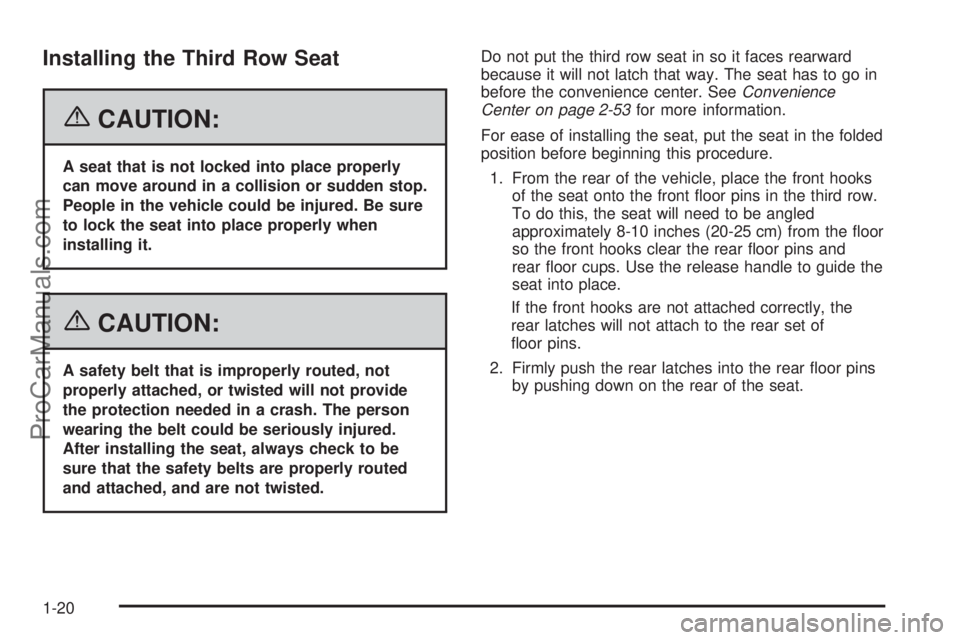
Installing the Third Row Seat
{CAUTION:
A seat that is not locked into place properly
can move around in a collision or sudden stop.
People in the vehicle could be injured. Be sure
to lock the seat into place properly when
installing it.
{CAUTION:
A safety belt that is improperly routed, not
properly attached, or twisted will not provide
the protection needed in a crash. The person
wearing the belt could be seriously injured.
After installing the seat, always check to be
sure that the safety belts are properly routed
and attached, and are not twisted.Do not put the third row seat in so it faces rearward
because it will not latch that way. The seat has to go in
before the convenience center. SeeConvenience
Center on page 2-53for more information.
For ease of installing the seat, put the seat in the folded
position before beginning this procedure.
1. From the rear of the vehicle, place the front hooks
of the seat onto the front �oor pins in the third row.
To do this, the seat will need to be angled
approximately 8-10 inches (20-25 cm) from the �oor
so the front hooks clear the rear �oor pins and
rear �oor cups. Use the release handle to guide the
seat into place.
If the front hooks are not attached correctly, the
rear latches will not attach to the rear set of
�oor pins.
2. Firmly push the rear latches into the rear �oor pins
by pushing down on the rear of the seat.
1-20
ProCarManuals.com
Page 27 of 458
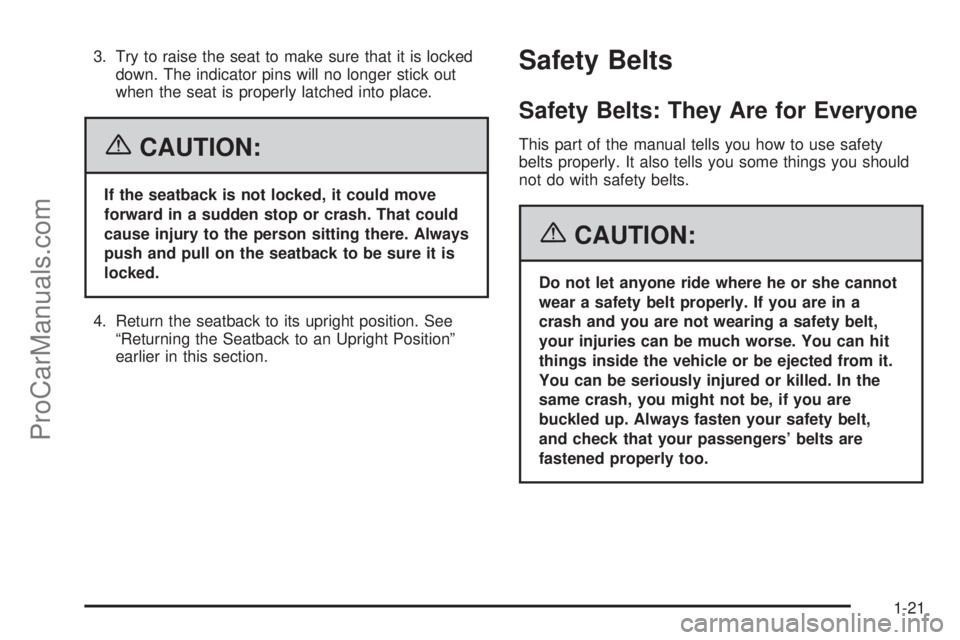
3. Try to raise the seat to make sure that it is locked
down. The indicator pins will no longer stick out
when the seat is properly latched into place.
{CAUTION:
If the seatback is not locked, it could move
forward in a sudden stop or crash. That could
cause injury to the person sitting there. Always
push and pull on the seatback to be sure it is
locked.
4. Return the seatback to its upright position. See
“Returning the Seatback to an Upright Position”
earlier in this section.
Safety Belts
Safety Belts: They Are for Everyone
This part of the manual tells you how to use safety
belts properly. It also tells you some things you should
not do with safety belts.
{CAUTION:
Do not let anyone ride where he or she cannot
wear a safety belt properly. If you are in a
crash and you are not wearing a safety belt,
your injuries can be much worse. You can hit
things inside the vehicle or be ejected from it.
You can be seriously injured or killed. In the
same crash, you might not be, if you are
buckled up. Always fasten your safety belt,
and check that your passengers’ belts are
fastened properly too.
1-21
ProCarManuals.com